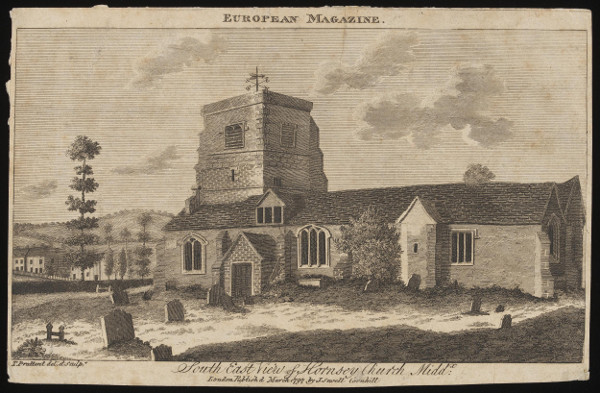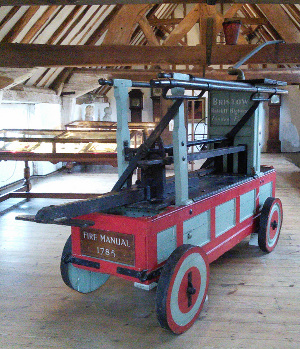|
Last week I was delighted to come across this 1785 fire engine in the Anne of Cleves House in Lewes, Sussex. It cost £65 5s 0d and was made by a company called Bristow which was based in Ratcliff Highway, Whitechapel, London.
Instructions for Use: When you play the engine to its full length hold the Branch steady, let as many men work at the Handles as can stand and likewise upon ye Treadles and take Quick Strokes from top to Bottom, when you play by Suction Unscrew the Brass Cap which stands by a Chain and screw the suction pipe when you play water out of the Cistern turn ye handle in again, let the Cistern be half full of water when you play by suction and Always keep water in the Cistern in summer but none in Winter. William Ince and John Mayhew were both directors of the Westminster Fire Office between 1763 and 1811[i]; John Mayhew serving six two year terms and William Ince four between 1771 and 1800. They attended the weekly board and carried out inspections of properties, writing up reports. This work would have provided useful business contacts, and they also introduced some of their customers such as the widow of the third Earl of Darnley and her son, who insured Cobham Hall in Kent for £24,000 in 1789. They insured their own property through the Westminster Office, receiving compensation when their house in Silver Street burnt down in 1782(£375) and again when William Ince’s house in Crouch End burnt down in 1795 (£215). William Ince designed a headpiece for the Westminster Fire Office policy documents in 1782 and in 1792 the firm provided 18 new chairs for the board for which they were paid £102 9s and later they were billed for other furniture when the Office moved premises. Ince & Mayhew owned a fire engine and were paid for the use of it. In January 1773 Ince received 4s 6d being so much expended by him at the late fire in Tylers Court and in 1779 they were paid one guinea to be divided among the men as have at various times attended and worked their Engine at Fires. There was also a fire engine at Hartlebury Castle, Worcestershire when William Ince did the audit there in 1781. The outgoing Bishop bought it and took it with him to Winchester. This fire engine was valued at £5 5s 0d. This video on YouTube shows you how a manual fire engine worked. [i] Roberts, H.. (1993). MAYHEW AND INCE AND THE WESTMINSTER FIRE OFFICE. Furniture History, 29, 134–139. Retrieved from http://www.jstor.org/stable/23407791  South East View of Hornsey Church by T. Prattent, published March 1797 © Victoria and Albert Museum, London South East View of Hornsey Church by T. Prattent, published March 1797 © Victoria and Albert Museum, London Both William Ince and John Mayhew were actively involved in the parish of Hornsey, which in the eighteenth century was a country area. William was living there from 1780 according to the Land Tax records, and he bought the Old Crouch Hall estate in 1788. John Mayhew had a villa in Hornsey and bought up land in the area. (A map in my book gives details.) According to the Vestry Minute Book for St Mary’s, Hornsey (London Metropolitan Archives DR0/020/C1/1) they were both surveyors for the highways and attended church meetings. William was eventually elected as Church Warden. In 1691 an Act was passed that required each Parish to appoint a Surveyor of the Highways who had to report to a Justice every four months on the state of the roads. He had to persuade the owners of land adjacent to the highway to keep them clear of any timber or other obstructions and cleanse the adjoining gutters and drains, as well as clearing any overhanging growth or hedges. The Surveyor was also responsible for organising repair of the highways by the parishioners. John Mayhew was surveyor and overseer of the highways for Hornsey from 1782-1784, and they were both surveyors in 1785 and overseers in 1788; William was surveyor from 1789 to 1791. In August 1792 there was discussion about paying Surveyors 10s a day instead of £50 for 6 days, as money had been used for road repair. On 22nd September 1792, the Minutes say William Ince was appointed as a Proper Person duly qualified to Serve the Office Surveyors of the Highways for Hornsey Side. From looking at an 1807 map, the Hornsey Side probably meant what is now the A103. In 1791 after the curate was so drunk that the congregation asked him not to preach, both Ince and Mayhew were present at a meeting when it was agreed to send a letter for a Gentleman to perform Divine Service constantly as … very much dissatisfied. On Easter Tuesday 1793, William Ince was elected Church Warden at his third nomination and he served until 1795 regularly attending meetings. While he was Church Warden there was agreement that the road needed to be widened and the surveyors were to apply to the magistrates. There was also discussion about enlarging the church yard and he and John Mayhew were members of the committee set up to look at the repairs and alterations. In December 1793 the Vestry agreed to examine what alterations were needed in the church for the accommodation of the inhabitants. There was seating for only 200 and demand for pews greatly exceeded the number that were available, so Mr Ince gave instruction for a general survey. The report offered two options: a new aisle or erecting a gallery. The Church Wardens reported that Many inhabitants refused to pay the rate to erect a gallery on the south side. They were advised they could enforce the said Rate and it was agreed to go ahead and cause the rate to be collected and get proposals for erecting the gallery on the south side, using any Overplus for repairs. However it would appear nothing actually happened until 1815[i]. In July 1795 Mr Ince produced his Accounts as Church Warden when his Expenditure amounted to £20-9-3, and in 1796 he was elected to a Committte to assist Officers in regulating the Poor of this Parish; this Committee to meet on first Monday of the month at six o’clock in the evening. It would seem that both partners of the firm were keen to have a decent road to get to their country villas from their workshops in Marshall Street, and they may also have found it useful for trade. It is interesting that William was more involved in his country life from 1793, spending more time there. He may have been less involved in the business by then. I discovered from reading Hugh Roberts article about the Westminster Fire Office, that William Ince’s house in Crouch End was destroyed by fire in June 1795. No wonder he stopped being Church Warden, but presumably he continued to live in Crouch End perhaps after the house was rebuilt - it was insured for £215. [i] A P Baggs, Diane K Bolton, M A Hicks and R B Pugh, 'Hornsey, including Highgate: Churches', in A History of the County of Middlesex: Volume 6, Friern Barnet, Finchley, Hornsey With Highgate, ed. T F T Baker and C R Elrington (London, 1980), pp. 172-182. British History Online http://www.british-history.ac.uk/vch/middx/vol6/pp172-182 [accessed 25 March 2016]. |
Author
Sarah Ingle is the great great great great grand-daughter of William Ince and has been researching her family history for a number of years. She thoroughly enjoyed the detective work involved in tracing William’s lineage. Archives
December 2022
Categories |


 RSS Feed
RSS Feed